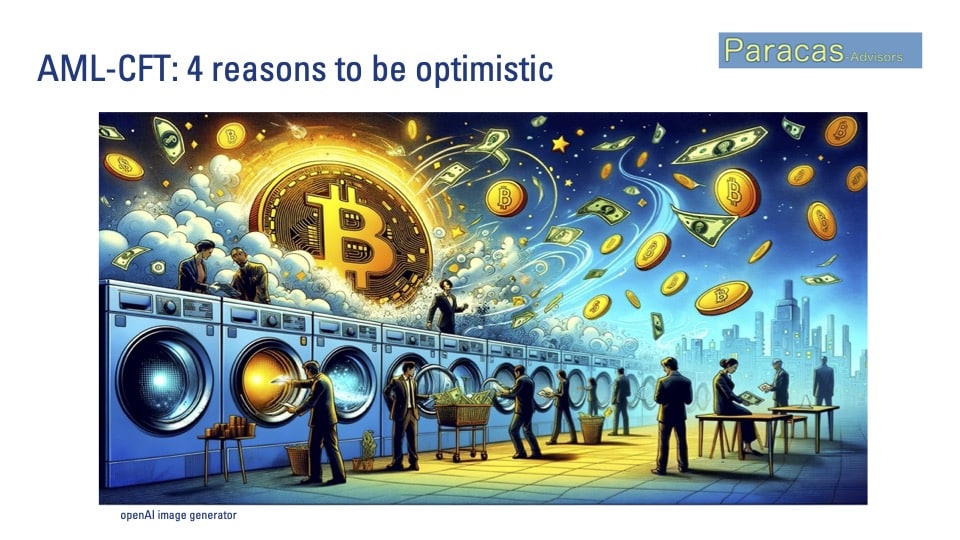
AML-CFT: 4 reasons to be optimistic about a stronger impact
On February 15th, 2024, the GIS – Geopolitical Intelligence Services AG – published an article by Elisabeth Krecke with a rather provocative title: “Why anti-money laundering policies are failing – In the fight against money laundering and terrorism financing, current methods are costly, ineffective, and excessively regulatory. There is hope: new tools are on the way.” https://www.gisreportsonline.com/r/why-anti-money-laundering-policies-are-failing/
The article is rather brutal in my view but gives interesting numbers. The anti-money laundering and combating the financing of terrorism (AML-CFT) efforts cost USD 274 billion, only to catch maximum USD 50 billion of dirty money out of minimum USD 2 000 billion…
A bad business case?
If the data provided in this article is accurate, it seems that AML-CFT regulations, and the financial institutions performing the controls, have a poor business case.
· 2% to 5% of global gross domestic product (USD 105 trillion) is laundered each year, i.e. between 2 to 5 trillion USD every year (source United Nations Office on Drugs and Crime – UNODC),
· Much less than 1% of dirty money laundered via the global financial system would be seized (source UNODC). That means 20 to 50 billion USD every year. The article refers to a 2023 Europol report that states that “terrorists, criminals and fraudsters always find ways to circumvent even the most complicated regulatory processes”. https://www.europol.europa.eu/cms/sites/default/files/documents/The%20Other%20Side%20of%20the%20Coin%20-%20Analysis%20of%20Financial%20and%20Economic%20Crime%20(EN).pdf
· The projected total cost of financial crime compliance across financial institutions worldwide is USD 274 billion in 2022, up from USD 214 billion in 2020 (source LexisNexis study “the True Cost of Financial Crime Compliance Global Study, 2023”,. https://risk.lexisnexis.com/insights-resources/research/true-cost-of-financial-crime-compliance-study-global-report ). Another study by the Competitive Enterprise Institute (2018) suggests that the cost of compliance (AML-CFT and all other regulations) would be up to USD 10,000 per employee for US corporations. https://cei.org/sites/default/files/Ten_Thousand_Commandments_2018.pdf#page=18
Despite the challenges, there are 4 reasons to be optimistic about the improved performance of AML-CFT efforts:
· New technologies, such as artificial intelligence and machine learning, are enabling more sophisticated detection of suspicious activity, increasing the effectiveness of AML-CFT processes. Ongoing research and innovation in the field of financial crime prevention promises to lead to new strategies and tools, enhancing the effectiveness of anti-money laundering measures in the fight against illicit financial flows.
· Increased international collaboration and cooperation between financial institutions, regulators and law enforcement agencies facilitates information sharing and strengthens collective efforts against financial crime.
· Global regulatory frameworks continue to evolve. The new European Anti-Money Laundering Authority (AMLA) for example will drive stricter compliance standards and a more efficient regulatory framework,
· Public awareness and societal pressure are driving financial institutions to prioritize ethical practices and transparency, further encouraging them to strengthen anti-money laundering controls.
Taken together, these four factors provide grounds for optimism that money laundering risks can be more effectively mitigated in the future. The AML-CFT fight can still be won!
Otras Notas
- The toxicity of sycophants: Internal Audit as a gatekeeper
- ECB on non-financial risks: severe conclusions from the annual analysis on outsourcing
- An Inspiring idea from Michael Diekmann, former Allianz Group CEO
- Evaluation of a Corporate Compliance Program – the DOJ approach
- An Inspiring idea from Paul Boyle and James Turner, former Aviva and Prudential Plc CAEs